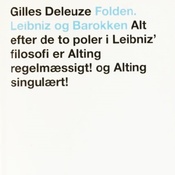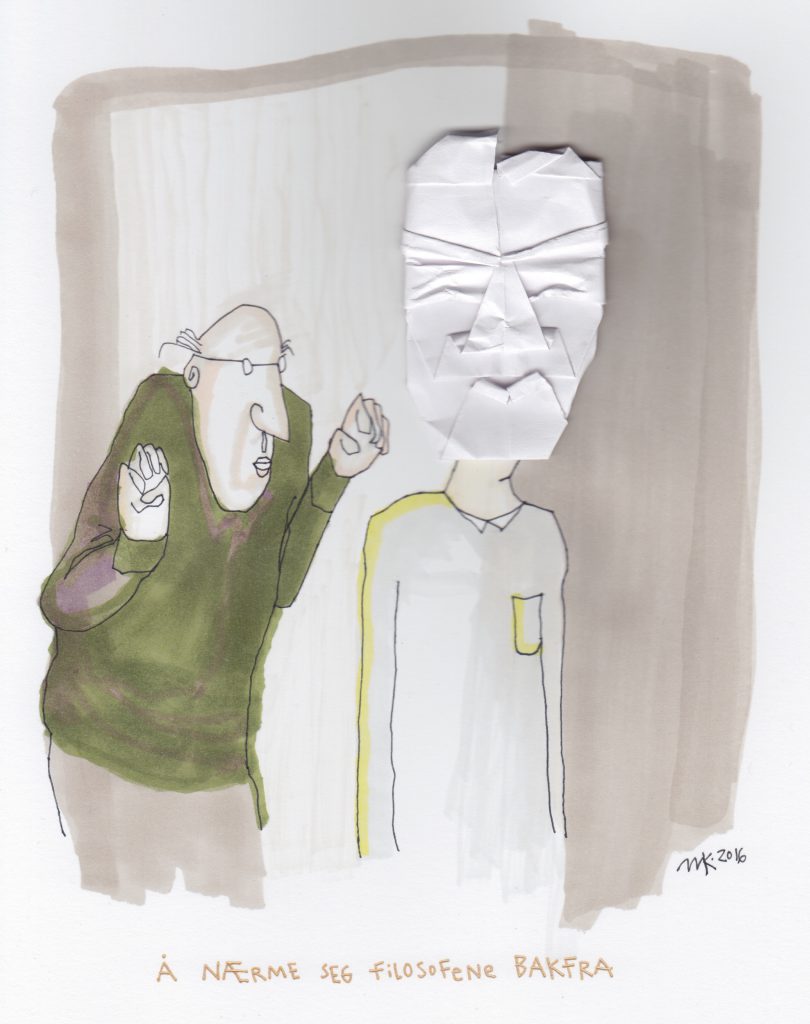(THIS ARTICLE IS MACHINE TRANSLATED by Google from Norwegian)
Gilles Deleuze:
The fold – Leibniz and the Baroque
The publishers of the visual arts schools, 2016
 What is a fold? Most people probably think of a wrinkle in a curtain or garment – or the Japanese paper figures in origami – but for French philosopher Gilles Deleuze fold the term that best explains the Baroque and the German philosopher Leibniz. Ever since the beginning of his career, Deleuze had re-read philosophers in original ways, which, some might think, are as much about Deleuze himself as he was about the thinkers. But his intention was also, as he himself put it, "to approach the philosophers from behind and give them bastard tongues" – so then surely there is no reason to complain.
What is a fold? Most people probably think of a wrinkle in a curtain or garment – or the Japanese paper figures in origami – but for French philosopher Gilles Deleuze fold the term that best explains the Baroque and the German philosopher Leibniz. Ever since the beginning of his career, Deleuze had re-read philosophers in original ways, which, some might think, are as much about Deleuze himself as he was about the thinkers. But his intention was also, as he himself put it, "to approach the philosophers from behind and give them bastard tongues" – so then surely there is no reason to complain.
Crystallization. There is no doubt that Deleuze's books on Nietzsche, Bergson and Spinoza – to name the most central – reactivated these thinkers for a new generation. There is also no doubt that through this series of re-imaginings of philosophy history we can follow Deleuze's own development, step by step, as a philosopher: The books can be regarded as a crystallization process, where different perspectives and concepts attach themselves to Deleuze's own style through writing.
We could also describe this writing practice, where he made canonized philosophers his own, or perhaps we should say part of himself, as a folding process. The outside, the established way of reading these thinkers stuck in when Deleuze approached them, was rewritten as thinking not based on respect for history's authorities or great thinkers, but philosophy as a way of life, as a line of escape, or a rhizomatic labyrinth, in which the pondering could not be separated from life itself.
 Cursor for processes. Deleuze thus extracted concepts from all the aforementioned thinkers and stamped them with his own seal. A central concept in the later part of his writing, though it already appeared in Difference and Repetition from 1968, was fold. In line with his reflections on Spinoza, where the point was a criticism of the distinction between thought and body through the immanence concept of Spinozism, Deleuze is looking for how Leibniz, in his monadology, rejects dichotomies and notions of the outside and the inside. The peculiarity of Leibniz is that the most abstract extends into the most intimate and physical, Deleuze thought: These are two sides of the same matter, of "moving matter." Simply put, we could say that the concept of folding puts our finger on the fact that there are neither delimited objects nor thoughts, since both are intertwined and, in the next, involved in processes where they cannot be separated from each other without losing their transformative identity. . A book, for example, is not just a literary object, but folded into a history of books and literature, as well as the library's history and thoughts on what it means to write and read.
Cursor for processes. Deleuze thus extracted concepts from all the aforementioned thinkers and stamped them with his own seal. A central concept in the later part of his writing, though it already appeared in Difference and Repetition from 1968, was fold. In line with his reflections on Spinoza, where the point was a criticism of the distinction between thought and body through the immanence concept of Spinozism, Deleuze is looking for how Leibniz, in his monadology, rejects dichotomies and notions of the outside and the inside. The peculiarity of Leibniz is that the most abstract extends into the most intimate and physical, Deleuze thought: These are two sides of the same matter, of "moving matter." Simply put, we could say that the concept of folding puts our finger on the fact that there are neither delimited objects nor thoughts, since both are intertwined and, in the next, involved in processes where they cannot be separated from each other without losing their transformative identity. . A book, for example, is not just a literary object, but folded into a history of books and literature, as well as the library's history and thoughts on what it means to write and read.
The special thing about Leibniz is that the most abstract extends into the most intimate and physical, Deleuze thought.
Creative process. The fact that every event and thing is contextually determined, and thus unstable, also means that it is included in contexts where it can become something other than what it initially is – and it is these opportunities that are so important to Deleuze. This we see otherwise in his writing, where the virtual, like the possibilities that exist at all times, defines the world around us. We must not hang on to concepts or things, but what happens between them, he says. The world consists of singular events, not autonomous things.
"The real subject is being," as he says with his companion Félix Guattari in their other collaborations A thousand plateaus. Or, to take a more concrete example from the same book, it is not the bee's fertilization of the flower or the flower's use of the bee as a reproductive organ that is the important thing, but their common being. The emphasis is on the event, on what happens, more than on the individuals who participate in the process. What happens is that the bee turns into a flower and the flower turns into a bee in the cross-pollination.
Inventive reader. In the Leibniz book this process is even more concrete, for, as Deleuze says in the foreword, the Baroque does not refer to "any essence, but rather an operative function, a trait". The Baroque, which is the time when the fold unfolds (!) Most clearly, according to the French philosopher, is not a style historical designation, but rather a way of seeing how the world is connected as processes and concrete creations. In Baroque architecture and visual arts, we see how a flow zone between outside and inside, exterior and interior, up and down, fiction and reality, is created.
Deleuze proves to be an inventive and at times both eccentric and funny reader of art history. About El Greco's painting Christ's baptism he says, for example, that "the ankle and the knee, [the lender] knees as a reversal of the ankle, the leg as an infinite wave".
The world consists of singular events, not autonomous things.
Today's media landscape. This process has just continued, and is stronger today than ever, where styles and reality levels are mixed at a high pace. Art forms where documentary elements are disseminated through many mediums, while the story is frequently cited, for example, are complex folds. And why not social media, where participants are fictionalized in real time? Here we have a veritable virtualization of reality and social, where the fold of reality does not favor separation, but a creation.
The only problem is that we may not see what being created, what singular event we are being folded into when chatting on Messenger – which may lead us back to rigid categories again. Resolution of dichotomies is not valuable in itself, especially if we do not see which terms, or what transformation, replaces those discarded.
Complex book. There is an optimism with Deleuze in his tribute to the creation that may seem a bit forced at times, for the resolution of the strong categories so heavily emphasized here can also cause one to lose the friction that would make the fold stand out clearly as a dissent or alternative way of relating to reality. If everything is in flux, if the fold folds into nth potency, there will only be chaos left. "The problem is not how a fold should be completed, but how it should be continued, passed through the ceiling, continued indefinitely," Deleuze writes. But that matter and form are not separate and that history and future utopias are always folded into the materiality of the world is an important insight. "This is because the fold does not affect only any substance which thus becomes an expressive substance," as he says. Matter itself is expressive, the thing has an expressiveness that surpasses its utility and function.
Nor should it be tucked under a chair that Fold probably Deleuze's most complex book – at times it is barely legible. It's not the one you start with, to put it this way. But will you really immerse yourself in Deleuze's concept of becoming – and having a lot of time available – this is the book for you.


